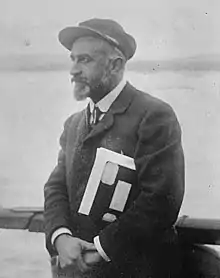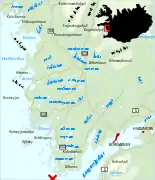Jean-Baptiste Auguste Étienne Charcot | ||||||||||||||||||
|---|---|---|---|---|---|---|---|---|---|---|---|---|---|---|---|---|---|---|
 Charcot in 1925 | ||||||||||||||||||
| Born | 15 July 1867 Neuilly-sur-Seine, France | |||||||||||||||||
| Died | 16 September 1936 (aged 69) at sea, off Iceland | |||||||||||||||||
| Nationality | French | |||||||||||||||||
| Occupation(s) | Polar explorer, doctor | |||||||||||||||||
| Spouse | Jeanne Hugo (1896–1905; div.) | |||||||||||||||||
| Sports career | ||||||||||||||||||
| Sailing career | ||||||||||||||||||
| Class(es) | 0 to 0.5 ton Open class | |||||||||||||||||
Medal record
| ||||||||||||||||||
| Updated on 2014-02-08. | ||||||||||||||||||
Jean-Baptiste-Étienne-Auguste Charcot[1][2] (15 July 1867 – 16 September 1936), born in Neuilly-sur-Seine, was a French scientist, medical doctor and polar scientist. His father was the neurologist Jean-Martin Charcot (1825–1893).
Life
.jpg.webp)
Jean-Baptiste Charcot was appointed leader of the French Antarctic Expedition with the ship Français exploring the west coast of Graham Land from 1904 until 1907. The expedition reached Adelaide Island in 1905 and took pictures of the Palmer Archipelago and Loubet Coast. From 1908 until 1910, another expedition followed with the ship Pourquoi Pas ?, exploring the Bellingshausen Sea and the Amundsen Sea and discovering Loubet Land, Marguerite Bay, Mount Boland and Charcot Island, which was named after his father, Jean-Martin Charcot.[3] He named Hugo Island after Victor Hugo, the grandfather of his wife, Jeanne Hugo.
Later on, Jean-Baptiste Charcot explored Rockall in 1921 and Eastern Greenland and Svalbard from 1925 until 1936. He died when Pourquoi-Pas ? was wrecked in a storm off the coast of Iceland in 1936. A monument to Charcot was created in Reykjavík, Iceland by sculptor Einar Jónsson in 1936 and another by Ríkarður Jónsson in 1952. The lichen genus Charcotiana was named in his honour in 2014.[4]
Charcot participated in many sports. He won two silver medals in sailing at the Summer Olympics of 1900.[5][6]
See also
References
- ↑ "Jean-Baptiste-Étienne-Auguste Charcot | French explorer and oceanographer". Encyclopedia Britannica. Retrieved 12 June 2018.
- ↑ "Jean-Baptiste Charcot". thefreedictionary.com. The Great Soviet Encyclopedia, 3rd Edition. 1970–1979. Retrieved 12 June 2018.
- ↑ Haas LF (October 2001). "Jean Martin Charcot (1825–93) and Jean Baptiste Charcot (1867–1936)". J. Neurol. Neurosurg. Psychiatry. 71 (4): 524. doi:10.1136/jnnp.71.4.524. PMC 1763526. PMID 11561039. and here.
- ↑ Søchting, Ulrik; Garrido-Benavent, Isaac; Seppelt, Rod; Castello, Miris; Pérez-Ortega, Sergio; De Los Ríos Murillo, Asunción; Sancho, Leopoldo Garcia; Frödén, Patrik; Arup, Ulf (2014). "Charcotiana and Amundsenia, two new genera in Teloschistaceae (lichenized Ascomycota, subfamily Xanthorioideae) hosting two new species from continental Antarctica, and Austroplaca frigida, a new name for a continental Antarctic species". The Lichenologist. 46 (6): 763–782. doi:10.1017/S0024282914000395.
- ↑ Bill Mallon (2009) [1997]. The 1900 Olympic Games: Results for All Competitors in All Events, with Commentary. Jefferson, North Carolina: McFarland. p. 19. ISBN 9780786440641.
- ↑ "Jean-Baptiste Charcot". Olympedia. Retrieved 29 December 2020.
- Le "Pourquoi pas?" dans l'Antarctique 1908–1910, Arthaud, Paris, 1996, ISBN 2-7003-1088-8
External links
- Jean-Baptiste Charcot at Olympics.com
- Jean-Baptiste Charcot at Olympedia
- Sur les traces du "Pourquoi-Pas?"
- Icelandic website in memory of Jean-Babtiste Charcot"
- Newspaper clippings about Jean-Baptiste Charcot in the 20th Century Press Archives of the ZBW
 Funeral of Charcot and his men in front of the Notre Dame, Paris, 1936
Funeral of Charcot and his men in front of the Notre Dame, Paris, 1936.jpg.webp) Board in memory of Charcot. Ittoqqortoormiit, Greenland
Board in memory of Charcot. Ittoqqortoormiit, Greenland.jpg.webp) The Pourquoi-Pas?, Charcot's ship
The Pourquoi-Pas?, Charcot's ship Adelaide Island viewed from the west
Adelaide Island viewed from the west Location of where The Pourquoi-Pas stranded
Location of where The Pourquoi-Pas stranded